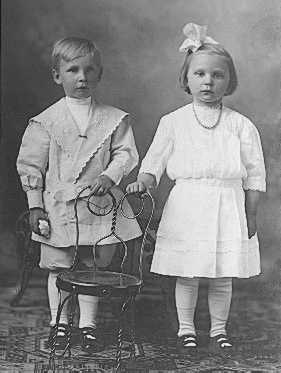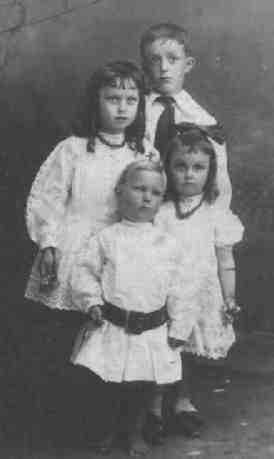
Boys' Tunics: Early 20th Century

Figure 1.--This American brother and sister were photographed in the 1900s. The boy's tunic has sailor styling, but buttons in the front and is belted. Note the black clip to hold the lapels together. The boys white tunic has embroidery on the lapels which have scalloped edgeing. He wear bloomer-style knickers, white stockings, and double strap shoes.
|
Tunics were one of the more enduring 19th century styles for boys and they endured into the early 20th Century. Tunics were commonly worn by little boys during the first 2 decades of the 20th Century. They were particularly popular in the 1900s. Tunics disappeared after the First World War. Some wealthy European children, however, continued to be dressed in tunic-like smocks at home into the 1920s and even the 1930s. We note that some of the later tunics were shorter and the boys more clearly wear knickers rather than bloomer knickers that are mostly covered by the tunics.
Tunics in the early 20th Century were similar to those worn in the 1890s. They were very popular in the 1900s and the 1910s. Tunic outfits like the one seen here (figure 1) as well as other styles were very popular for younger boys in the 1900s. We also commonly see them in the 1910s, perhsaps not quite so commonly. After World War I (1914-18), however, they quickly disappeared from the fashion scene. We note them in the early 1920s, bith actual tunics and tunic influence garments. We note very few examples of tunics by the late 1920s as a variety of other styles appeared for younger boys. This precise transitioin is a little difficult to follow as so many period snapshots are undated.
Jacket Styles
Tunics came in a variety of styles. One common fearure on almost all boys tunics were front buttons and a largely ornamental belt.
Sailor styling
Sailor styling was popular with tunics. Sometimes the sailor styling was only basic. In other tunics it was quite detailed. Many of these sailor tunics were very plain, others were highly styalized, even with lace and ruffles.
Russian styling
Many tunics were done in the Russian style with no collar, but a closed neck all around. Buttons were usually set off to one side
Lace and ruffles
While some tunics were plain, others had elbaorate lace and ruffled work. This was generally found on some of the tunics with sailor styling. The lace and ruffles was worked into middy collar. Some suits had scalloped work around the middy collar. Some fancy tunics might also have elegant embroidery on the lapels or in other locations.
Materials
I have not yet been able to develop details on materials.
Colors
Tunics were available in a wide variety of colors. All white tunics and white tunics with colored trim appear to have been particularly popular, especially in the winter. I believe that white tunics were considered particularly dressy and suitable for the most formal occasions, especially when worn with a wide-brimmed sailor hat. Tunics were also made in many colors, but I have not yet developed details on this. Some tunics were all white, but many had colored trim. Blue was a common color for the trim, but other colors were used as well. A good example of a tunic with a colored trim is a photographed we have found that of an young American boy that was touched up with water colors. The American boy is unidentified, but we believe the portrait was done about the turn of the 20th century.
Countries
Tunics for younger boys were a popular style throughout Western Europe, Britain, and the United States. I do not yet have details on how styles varied among countries. I believe the fancier styles with lace and ruffles were most popular in France and Italy, but more details needed to be developed here.
Caps and Hats
Boys generally wore sailor caps and hats with their tunics. Wide-brimmed sailor hats were the most common for dress wear.

Figure 2.--This American boy also wears a white tunic with Russian blouse styling in the early 1900s. Note the belt which was a feature of most tunic suits. Boys at the turn of the 20th Century began wearing their tunics without stockings during the summer.
|
Pants
Boys by the 20th Century primarily wore bloomer-style knickers that had elasticised leg hems with their tunics. The knicklers were worn both below and above the knee. Above the kneen seems to have been the more common style. The knickers were always bloomer style and never the knickers with button or buckle closures that the older boys wore. We have seen some boys wearing kneepants with their tunics. We note one American boy wearing kneepants with a tunic suit, but this was in 1924 after the tunic popularity had largely passed. The bloomer knickers, however were much more common.
Shoes and Stockings
Tunics in the 19th Century were mostly worn with long stockings. By the 20th Century boys were wearing their tunics with short socks or during the summer go barefoot in tunics. If they were dressing up in their best tunic they wold be more likely to wear long stockings. During the summer short socks were becoming increasingly acceptable, even for dressup wear. Generally white stockings were worn with white tunics and dark stockings with dark suits.
Ages
The boys wearing tunics by the early 20th Century were genrally younger boys. They appear to vary in age from about 2 to 6 or 7 years of age.
Tunics were primarily a boys' garment. HBC has noted, however, girls wearing them in the early 20th century. Perhaps they were girls with older brothers and wearing hand-me-downs. Boys might have a tunic suit as his dress outfit. While girls might wear tights, they would not wear them as a dressoutfit. Girls would dress up in a frilly party dress--not a plain tunic. I'm also not sure that tunics were actually made for girls.
Tunics and the bloomer knickers boys wore under them were worn at different lengths over time. The bloomer knickers have varied more than the actual tunics. The bloomer knickr were worn at lengths below or above the knee, but the tunic itseld was motly worn at lengths just above the knee. Tunics at the turn of the 20th century were worn at a length ending just above the knee. The bloomer knicker boys wore with these were worn at almost the same length, often just barely visible below the hem of the tunic. They were generally worn bloused just above the knee. We note that some of the later tunics were shorter and the boys more clearly wear knickers rather than bloomer knickers that are mostly covered by the tunics. By the late 1910s we notice some boys wearing tunivs looking increasibly like jackets.
Conventions
I am not sure about the conventions for wearing tunic suits. I believe they could be dress outfits for younger boys. This is especially true of the fancier outfits. They may have been worn much like a Fauntleroy suit in an eralier period. Planiner suits, however,
appear to have been worn as everyday or play wear.
HBC

Navigate the Historic Boys' Clothing Tunic pages:
[Return to the Main tunic page]
[Return to the Main historical tunic trend page]
[National styles]
[Tunic styles]
[Tunic accessories]
[ Pantalettes]
[ Stockings]
Navigate the Historic Boys' Clothing Web Site:
[Introduction]
[Activities]
[Biographies]
[Chronology]
[Clothing styles]
[Countries]
[Bibliographies]
[Contributions]
[Essays]
[FAQs]
[Glossaries]
[Satellites]
[Tools]
[Boys' Clothing Home]
Created: March 19, 1999
Last updated: June 10, 2004




